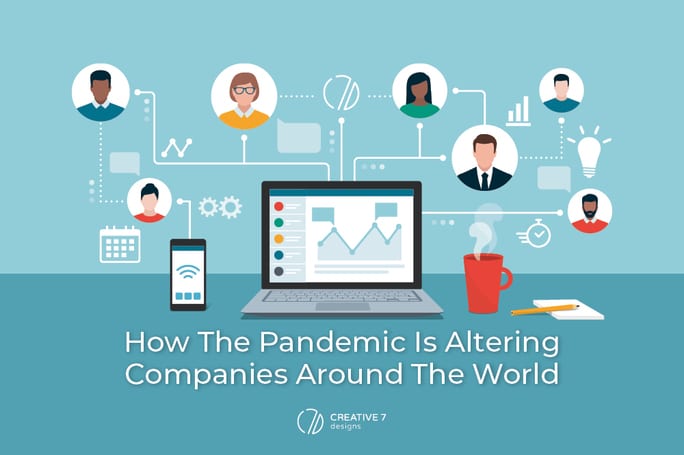As we move forward from 2020, the C7D team addresses how large and small businesses have been affected short- and long-term by COVID-19 and what this means for the world’s future.
What do you do when you take a life-threatening virus and sprinkle it around the world at the beginning of the year? You get a whole lot of chaos and a whole lot of lasting effects that linger into the end of the year and the upcoming year.

We’re aware this isn’t our first time talking about the pandemic and its effects on businesses around the world (and it likely won’t be our last). The C7D team stressed the importance of being able to boost one’s online presence during the pandemic — doing so proved critical to a business’s success as the world welcomed an unexpected shift from in-person business to online everything. When the CDC announced the life-threatening virus, brick-and-mortar businesses were put to an abrupt halt and digital marketing trends quickly highlighted the reliance on artificial intelligence (AI), video marketing, interactive content, and more.
For businesses that were ahead of the curve, updating one’s website was a means to keep business flowing; this wasn’t something that proactive businesses remembered to do only once the virus hit. We can be sure that reactive businesses now understand the importance of maintaining an active online presence.
Still, for businesses that didn’t think a pandemic would slow their in-person traffic, the struggle to survive due to the mandated shutdowns during the COVID-19 pandemic resulted in a handful of especially unprepared businesses that were operating on thin, easy-to-break margins. However, there’s one good thing — the pandemic isn’t prejudiced (misery loves company, right?). COVID-19 affected any and every business, no matter the location, size, and industry. Think we’re lying? Remember when Lysol ran out of disinfecting wipes? The official USA Today website published an article that addressed this issue: “Manufacturers like Clorox were not prepared for skyrocketing demand.” When the Environmental Protection Agency (EPA) stated that Clorox 4-in-1 Disinfecting Spray and Lysol Disinfectant Spray were among the products that could likely protect against the spread of the coronavirus, people bought. And how else did we expect the masses to react? According to Patrick Penfield, the professor of the supply chain practice at Syracuse University, “Nobody ever expected this to happen, and they got caught flatfooted.” The results are that these big companies simply don’t have enough ingredients or the capacity to meet the increasing demands of scared consumers around the world. So, the pandemic truly proved to be non-biased.

Though, sometimes (just sometimes), we wished the pandemic wasn’t so liberal, this forced businesses to rethink both internal and external processes. Do we stay, or do we go? What about the office space we’ve rented out? What do we tell our customers? Is our website still working — do we even have a website? Do we have enough hand sanitizer…wipes…face masks? These were the kinds of questions that began to flood conversations. With the government forcing a lockdown, SBOs and large business owners were left scrambling at the last minute to find any alternative to uphold business without in-person interaction.
The personal affects of the pandemic on us
At C7D, we were privileged to be able to successfully carry out all of our work digitally. Really, it was a luxury to be able to pick up our work stations, so to speak, and work from anywhere in the world (we say this with humility).
C7D owner and CEO, Joseph Kibler, talks about this subject in this article that was published shortly after the team reconvened after a nearly three-month stay-at-home and work-from-home period. When asked about COVID-19 and how limitations at the time changed how a business owner thinks, Kibler commented that the pandemic made it “very hard on business in different ways.” Describing the effects of the pandemic on the team as “stressful for everyone,” Kibler said that the biggest challenge during the climax of the pandemic was sales.
“Many clients [were] more cost-conscious … [and were struggling] with the same thing — knowing the costs of doing business but also realizing that everyone is cutting costs.” Kibler’s main concern was being able to provide services and get new jobs without being able to have face-to-face meetings.
But, it wasn’t a total loss for C7D amid the pandemic. While the sales had slowed down, Kibler followed up with how the team didn’t really need to “find new ways to work.” Most of us simply had to work in different environments (no longer in the office) and were able to set up a work station with ease in the comfort of our homes. Kibler said that the key in having a team work remotely is “keeping communication flowing whether schedules or environments are shifted or not.”
The pros and cons of working from home
Kibler was also pleasantly surprised to see how well the team persisted through the quarantine. With everyone working from home in their PJs and a couple of new team members, there were natural doubts. The reason working from home could be difficult is because creating that discipline to work from home is a learned skill. Comfort, distraction, and minimal to no face-to-face outside communication for hours could decrease work productivity. While some research reveals the increase of at-home work production initially, further studies show the opposite over time.

According to an article published by S&P Global, “Research by 451 also found that only 11% of employees felt more productive and more engaged with remote work than work from the office. […] About 35% of workers surveyed said they felt more productive but not more engaged,” while roughly 55 percent said they were both less productive and less engaged working from home. This could be a direct result of individuals struggling with anxiety, not feeling focused, and a lack of alignment with their work team.
Kibler, however, recaps that workflow persisted, which was more of a delight than a surprise. Were there some bumps and challenges along the way? Of course, and given the situation, these are to be expected. However, Joseph still recalls that it was a delight that everyone on the team handled their part.
Useful information to prepare businesses to stay afloat in the future:
– The Biggest Business Impacts of the Coronavirus Pandemic
– (Quick Read) Coronavirus: Business & Economy
– Effects of Covid-19 On Business and Research– The State of Fashion 2021: In Search of Promise in Perilous Times


